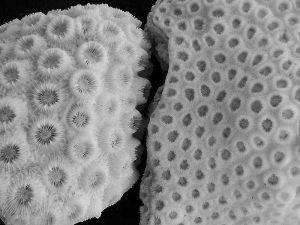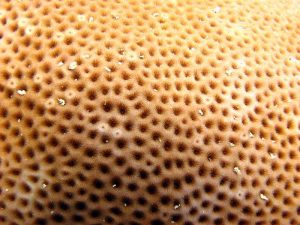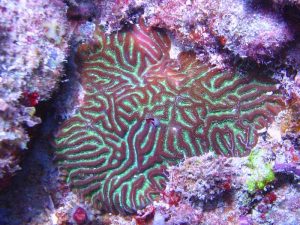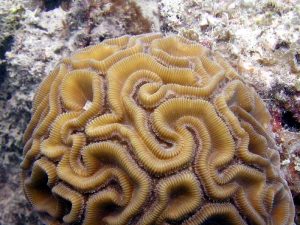
The reef scene depicts four West Atlantic coral species which are covered in this article: Siderastrea siderea at left, Diploria labyrinthiformis in the middle, Montastrea annularis at right and Diploria strigosa at bottom center. Aldo Croquer.
Siderastrea is a genus of small polyped stony corals which is also known as starlet coral. The three species are most often colored pale to dark brown but they can be vivid pink or blue in shallow water. In ideal reef conditions Siderastrea siderea commonly grows to two feet in diameter and it sometimes grows to twice that size. The genus grows into massive, encrusting or hemispherical shapes.
S. radians is the most durable Siderea species and it perhaps the most extreme stony coral in the Atlantic Ocean. It is the only coral which can be found growing high in the littoral zone, in inter-tidal pools which can experience very high temperatures. Although these colonies are pale and stunted, they still occur at great abundance in these stressful environments. In shallow water, S. radians is mostly brown but it can be difficult to distinguish from the similar yet slightly smaller polyp S. siderea. S. radians is frequently brought into the aquarium trade on Florida aquacultured live rock.
S. stellata are typically smaller encrusting or hemispherical colonies which occur at intermediate depth. The species has the larger, more recessed corallites of the Siderea species. The corallites have a polygonal shape with bright corallite walls, giving the coral a noticeable honeycomb pattern. The species is rarely very large and not very abundant.
S. siderea is largest and most abundant member of the genus. It is more common in shallow water where it will be encrusting to submassive when small and hemispherical when it is large. In some environments it will often develop a brilliant pink or blue color, especially on the side which is receiving the most light. The corallites of S. siderea are of intermediate size for the genus, they are slightly recessed and they appear as little pits on the surface of the colony.
Madracis occurs in both the Atlantic and Pacific Oceans and it is represented in the tropical West Atlantic by no fewer than five species. The Madracis genus belongs to the Pocilloporid family which makes it closely related to familiar aquarium corals such as Stylophora and Seriatopora. Like its Pacific counterparts Madracis grows into various branching shapes but there are also a few species which are cryptic and encrusting. The polyps are very small and often extended during the day, giving Madracis species a fuzzy appearance.
M. mirabilis grows into thin, pale yellow branches which is why it is called yellow pencil coral. In its marginal, deepwater habitat M. mirabilis occurs as small isolated patches but it is most abundant in shallow water where it forms large, sometimes extensive monotypic stands. The open nature of the skeleton provides refuge for a host of cryptic and commensal creatures which densely colonize M. mirabilis colonies, leaving just a few inches of living tissue at the tips.
M. decactis and M. formosa are corals with very similar growth forms but they are identified by minute skeletal features. M. decactis is paler in color, usually olive or tan, with short bulbous branches and ten primary septa visible in the corallites. M. formosa is darker in color, often dark brown with pale corallite centers and eight primary septa visible in the corallites. M. formosa colonies are also larger with broad, slightly flattened branches. Both species co-occur at intermediate to great depths but M. decactis is generally more common than M. formosa.

Under ideal reef conditions Siderastrea siderea can grow to massive sizes. This large spherical colony was over four feet in diameter.
Faviids
Favia fragum is a fast growing yet short-lived coral species. The brown, tan or orange colonies are crustose or hemispherical and they rarely grow much larger than a couple of inches across. The polyp mouth is recessed into the skeleton but the corallite itself can be exert from the surrounding skeleton.
F. fragum goes by the name of golf ball coral and it is can sometimes found growing on Florida aquacultured rock. It can be found in shallow water habitats above about twenty feet and it is particularly abundant in backreefs and other environments with slightly reduced wave action. This coral can resemble small colonies of Dichocoenia stokesi but that species has much more exert corallites and more noticeable septa around the corallite walls.
Colpolphyllia natans grows to the largest size of all massive corals in the tropical West Atlantic Ocean. C. natans commonly grows to over six feet across with some of the largest individuals reaching twice that size. The surface of the coral colony has wide meandering grooves with darker colored ridges. The skeleton is so porous that it can float once dried out which has led to some archeological confusion in the past when specimens of this species were found far from any modern tropical coral reefs (Korniker and Squires 1962). This genus is one which was found to have a significant enough divergence from the Faviid family lineage to suggest being placed in a separate family (Fukami et al 2006).
Diploria is an abundant and important reef-building coral genus on West Atlantic reefs. The genus contains only three species which grow into diverse forms but they are easily distinguished based on the size and density of their grooves. Ancient Diploria fossil skeletons are the source of the famous Florida Keystone. The three species of Diplora co-occur together in all environments but they have separate peaks of abundance based on depth. The long continuous valleys of Diploria species most resemble Leptoria and Australian Goniastrea species which are available in the aquarium trade.
D. clivosa is the least common of the Diploria species. It is only found in shallow water habitats above fifteen feet where there is a generous amount of water motion. The color is usually pale brown or olive but very occasionally it can have brilliant green grooves with contrasting dark brown ridges. D. clivosa colonies grow encrusting or hemispherical shapes with small, tightly meandering grooves and a knobby irregular surface.
D. labyrinthiformis is a very fleshy species with deep meandering corallite valleys. The width of the corallite valleys varies greatly between specimens but the species is easily recognized by the presence of a noticeable groove on the ridge between the valleys. Even during the day the polyp tentacles are often visible protruding slightly through the narrow valleys. C. labyrinthiformis most often grows into hemispherical shapes on the seaward part of reefs. Although the species can occur at all but the shallowest depths, it is most abundant Diploria species on intermediate to deeper reefs. Colors of D. labyrinthiformis are most often pale tan, grey or olive with the occasional specimen being pastel yellow or green.
D. strigosa is the most common Diploria species on many West Atlantic reef habitats. The species is frequently a dominant coral of shallow water reefs where large hemispherical colonies often grow to over three feet in diameter. The meandering continuous corallite valleys are regular in appearance and evenly spaced. Corallite valleys are mostly perpendicular to the colony edge, often with brightly colored grooves which contrast with the darker colored ridges. D. strigosa is a frequent host of Spirobranchus featherduster worms and some older colonies become veritable featherduster condominiums. The species is most abundant at shallow to intermediate depths.
Manicina areolata is a Faviid but because of the puffy appearance of the fleshy tissue it often resembles a Mussid. Although this species doesn’t usually get much larger than a few inches across, in certain shallow backreef and lagoonal habitats it can occur at densities well above a dozen individuals per square meter. Juvenile Manicina corals begin life as a conical oval shaped polyp which is attached to a substrate by a central stalk. The most common areolata growth form has tighter valleys and it will maintain an elliptical outline with a conical base that can remain attached or become free-living and lying in the substrate.
The less common mayori growth form has wider valleys and it grows to a larger size with a flattened underside. Although nearly all Atlantic stony corals are unavailable in the aquarium trade, this species is an exception. Manicina frequently grows out on cultured live rock from the Tampa Bay area and it is available from dealers who request this coral along with their rock. The free living form of Manicina greatly resembles the common Trachyphyllia coral.
Montastrea is a prominent genus of Atlantic corals which also occurs in the Pacific Ocean. The genus is the second most important contributor to the reef building process after Acropora. The genus contains four recognized species although there is some evidence to suggest that the larger polyped M. cavernosa may comprise more than one species.
M. annularis is a fast growing coral which forms large aggregations of lobed colonies in shallow water. Although the individual lobes of M. annularis are usually no more five to six inches across, the aggregations may form large single species stands.
In deeper water the lobes become cylindrical columns with live tissue mostly on the topside of the columns. The surface is relatively smooth overall with the color usually appearing tan, creamy brown or green. The species was long thought to contain three distinct growth forms but those have since become reclassified into three separate species. The small polyps of Montastrea species in the annularis complex can resemble the Cyphastrea species of the Pacific Ocean.
M. faveolata is a small polyped Montastrea which is common on a wide range of reef habitats but it is most abundant at intermediate depths. The colonies are encrusting or hemispherical when small becoming mound-shaped and plating at the edges when large. Huge, thousand year-old colonies can grow to over a dozen feet across. The surface is mostly smooth, appearing grey or tan, sometimes with bright green or yellow colored polyps.
M. franksi is the deepwater representative of the small polyped Montastrea species. M franksi usually grows encrusting, hemispherical or plating with a bumpy nodulous surface which is unlike any other Montastrea species. The tissue is pale brown or grey overall with irregular, lighter colored patches and orange to reddish polyps. M. franksi colonies do not grow to nearly the size of the other Montastrea species.

This image taken in shallow water shows D. labyrinthiformis on the left and D. clivosa on the right.
M. cavernosa is the large polyp representative of Montastrea in the Atlantic Ocean. The colonies grow into massive boulder or hemispherical shapes at intermediate, becoming increasingly plating with depth. M. cavernosa is a highly variable species which occurs in many colors including red, pink, brown and blueish with green, yellow or white polyp interiors. The corallites are strongly exerted from the surrounding skeleton with two distinct forms which have different abundance distributions separated by depth. The small polyped form has cone-shaped corallites, is more abundant in shallow water and it usually has polyps extended during the day. The larger polyp form has button shaped corallites, it is more abundant in deeper water and the polyps are rarely extended during the day. One morphological study found enough differences between the two forms which could not be explained by environmental factors to suggest further investigation into the taxonomic status of the species (Amaral 1994).
The next article will conclude the coverage of West Atlantic corals with the large polyp stony corals and it will also cover the fire corals and some of the non-reefal corals.
Reference:
- Amaral. F. D. Morphological variation in the reef coral Montastrea cavernosa in Brazil. Coral Reefs. Volume 13, Number 2 / May, 1994.
- Fukami, Hironobu, Ann F. Budd, G. Paulay, A. Solé-Cava, C. Allen Chen, K. Iwao & N. Knowlton. 2004. Conventional taxonomy obscures deep divergence between Pacific and Atlantic corals. Nature 427: 832-835.
- Humann, Paul and Ned DeLoach. 2002. Reef Coral Identification. New World Publications Inc. Jacksonville, Florida.
- Kornicker, Louis S. and Donald F. Squires. 1962. Floating Corals: A Possible Source of Erroneous Distribution Data. Limnology and Oceanography, Vol. 7, No. 4 pp. 447-452
- Lesser, Michael P., Charles H Mazel, Maxim Y Gorbunov, Paul G Flakowski. 2004. Discovery of nitrogen-fixing bacteria in corals. Science. Vol 305: 995-1000.
- Wood, Elizabeth. 1983. Corals of the World. T.F.H.

D. strigosa frequently hosts featherduster worms and old colonies may accumulate an abundance of them over time.

The red fluorescence of M. cavernosa was recently determined to be caused by symbiotic, nitrogen-fixing bacteria (Lesser et. Al 2004).

This image depicts the large difference in corallite size and spacing of the two supposed forms of M. cavernosa.





























0 Comments